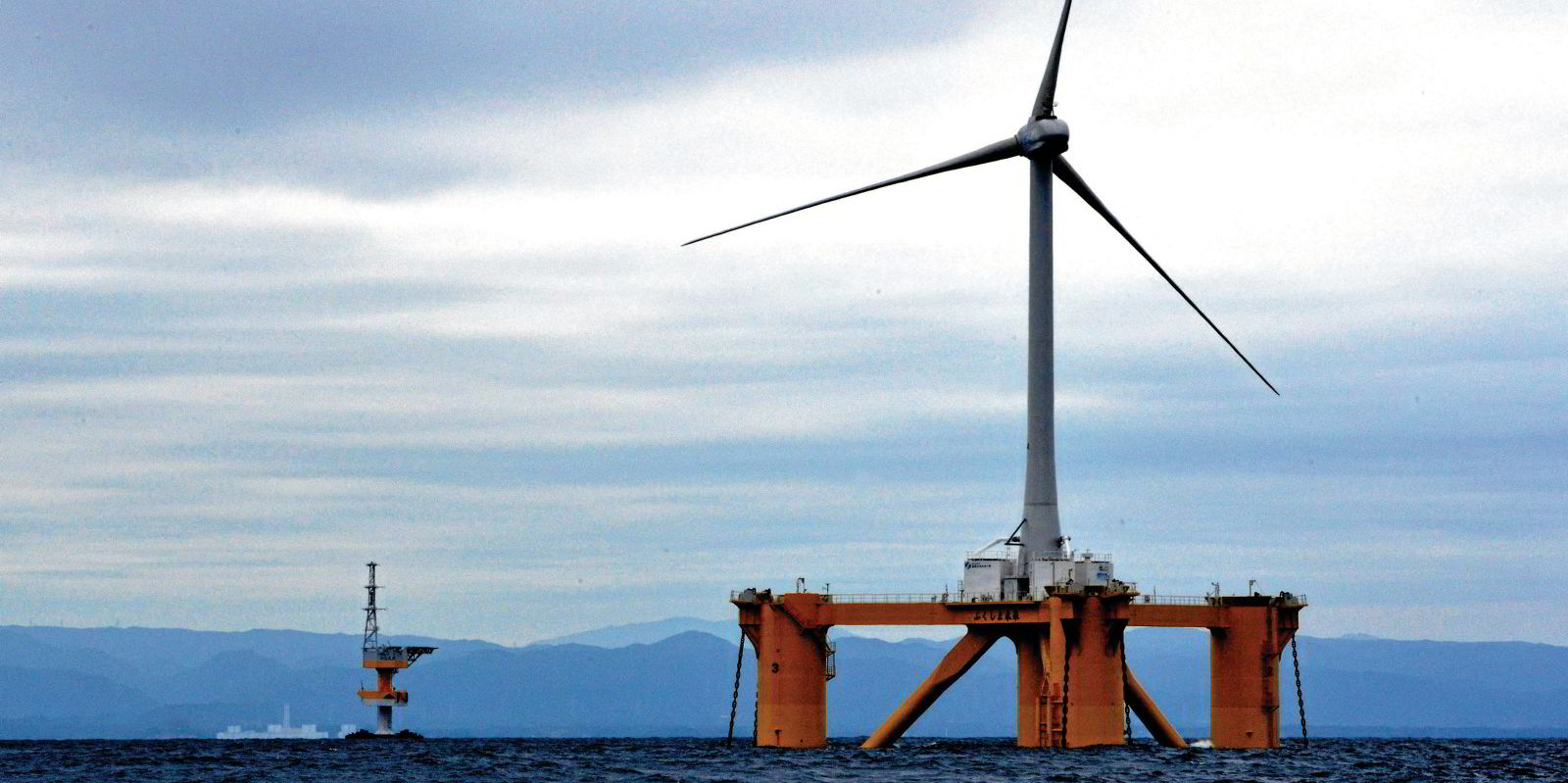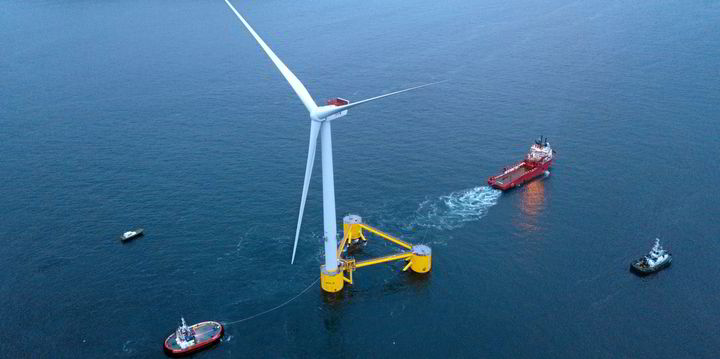Twenty-five kilometres offshore from the site of the 2011 Fukishima-Daiichi nuclear disaster a floating wind power project is presenting Japan with an opportunity to take its energy sector in a new direction.
Though much smaller than the gigawatt-scale arrays under development in the world’s major maritime wind provinces, the 30 megawatts Japanese pilot project could influence the direction to be taken in an emerging sector and impact the island nation’s wider industrial future.
The project, being built by utility Tokyo Gas, will be a return to deep water wind for a maritime country that was an early adopter of floating technology.
Within three years of the Fukushima melt-down, Japan had switched on the world’s first multi-unit array — the Fukushima Forward demonstrator —but has since has made little progress in the field beyond an 16MW array off the Goto Islands.
Proving floating wind’s commercial viability using today’s ultra-large turbines models and next-generation platforms is the central rationale of the project, to be constructed in 100 to 200 metres of water using 15 MW machines and hulls from Aker Solutions subsidiary Principle Power.
Japan is home to a power-hungry population of 125 million increasingly calling for a renewables-led energy transition away from fossils and nuclear.
Article continues below the advert
But the island has limited acreage on land for solar and only the narrowest of continental shelves to accommodate bottom-fixed offshore wind projects, making floating key to the government’s goal to have 45 gigawatts of plant turning at sea by 2045 —where it currently has only 140 MW operating — as part of a national net-zero energy mix.
“Knowing the geographic conditions of Japan there will be massive potential for floating wind and we want to be the front-runner here in this industry. Deploying floating wind technology into Japanese waters is our main focus,” says Michiko Hirose, the head of the offshore wind business at Tokyo Gas, which made a ¥2 billion ($15.6 million) investment in Principle Power in 2020.
“We are starting with a small-scale, pre-commercial project that we need to launch to go through the Japanese process, including the certification bodies and so on. Our aim is to take floating wind quickly into industrial-scale. Getting costs down means scaling up.”
“I am often asked why we do not start with a large-scale floating wind project, given precommercial-scale projects already been deployed in Europe,” she adds. “But we believe it is essential, especially in Japan and in metocean conditions that are very unique, because we need to speed up progress in this sector, from certification on, if we are to achieve the national goals set.”
Tokyo Gas’ lofty ambitions for this new Fukushima flagship are anchored in an informed conservatism around the technologies involved. The Fukushima Forward demonstrator offered many hard lessons to the Japanese industrial consortium that devised it — as it did the wider offshore wind sector — but the biggest take-home was ‘floating wind is high-tech and high-cost’.
The desire to “rule out risk with mature technology” led Tokyo Gas to choose Principle Power’s steel semisubmersible WindFloat platform, first prototyped off Europe in 2011 before going on to be used on two of the largest floating wind arrays operating, the 25 MW WindFloat Atlantic off Portugal and the 50 MW Kincardine in the North Sea off Scotland.
Our aim is to take floating wind quickly into industrial-scale. Getting costs down means scaling up
Tokyo Gas’ Michoke Hirose
Principle Power’s chief commercial officer Aaron Smith says: “Taking a technology that you know works and deploying it here [off Japan] should be a guaranteed success and this is a prerequisite for people [in government and industry] to become comfortable with the prospect of gigawatt-scale, over-the-horizon type projects.
“In all the markets we are in, we see having steel in the water is a complete gamechanger. It gives countries confidence to move. So, this small project off Fukushima [because it is managed by a prefectural regime rather than national auction system] is going to be a way to get steel quickly into the water.”
Though Japan has world-leading maritime and shipping industries and highly developed coastal infrastructure, to meet the demands of a fast-growing floating wind market the country’s network of ports and harbours will need to be the “first area focused on”, said Smith, as these facilities will underpin a virtuous circle of development of the local supply chain and accompanying job creation as deployment gains momentum.
“We think that Japan has a huge opportunity and it is about how you unlock the move to scale,” he said. “If you have ports that are ready on time [ to support lead-off industrial scale projects] then you build the supply chain behind them. You can make sure there is a place to build and install turbines locally and that is really important when it comes to deciding where to put new factories or facilities.”

Hirose adds: “Getting to gigawatt-scale we will need a strong supply chain in Japan. We knew Principle Power’s platform technology was the right one for Japan’s geographic conditions, so, with their collaboration, we are launching a programme that looks into developing the supply chain for mass production [of the WindFloat] using a modularised design.”
Japanese mission
Tokyo Gas’ Fukushima pilot will be a testing ground for the industrial development needed if floating wind is going to take up the place foreseen for it by the Japanese government off its shores – and as urged on by the Japanese Wind Power Association in its lobbying to open vast areas beyond its territorial waters in the so-called Exclusive Economic Zone (EEZ) as part of a package of “urgent measures” to spur on progress in the sector.
The first phase of Tokyo Gas’ Fukushima pilot will focus not just on the manufacture but also the installation process for the single units and how it can we extrapolated for future gigascale projects.
“We are looking for the right ports and shipyards for the pilot while thinking about the future too,” Hirose says, pointing out that the Japanese government is looking into reforms to offshore wind policy with a Green Innovation Programme and has taken expressions of interest from potential governmental authorities where ports are candidates for receiving support.
A follow-on phase of the Tokyo Gas project would be timed with the next Japanese offshore wind auction, to bring in a developer to partner on expanding out the project from pilot to industrial-scale, potential as large as 1GW, in the process helping “push this supply chain creation to a much higher level”.
Smith adds: “One of the challenges of these smaller projects is that you have to make do with what [coastal industrial infrastructure is] available to start with because you simply cannot afford to cover huge capex [capital expenditure] outlays for this sort of thing.
“What we are trying to do is to leverage the lessons from [building the WFA and Kincardine projects in] Europe against the engineering work we are doing in Japan and the base ports concept from MLTI [Japan’s ministry of land, industry and transport] to make sure these [industrial hubs] can built in the right locations and with the right features that are future-proofed for the industrial scale-up ahead.”
WindFloat’s generation game
The WindFloat wind turbine platform started as an import from the offshore oil & gas industry, a scaled-down steel semisubmersible engineered around a three-column ballasting system that has evolved over the last decade through three design generations.
The triangular hulls have been fitted with turbines from 2 MW up to 10 MW models, but for the Fukushima pilot will be mated with giant 15 MW machines for the first time.
Submission of the project’s environmental impact assessment — a key milestone in the project timeline — now done, Tokyo Gas foresees construction starting in 2026 and rotors turning the following year.
“The industry has had experience with many sizes of turbine but I do think 15 MW turbines present challenges though it will be achievable, working with Principle Power,” says Ryo Isawa, who is heading up Tokyo Gas’ floating wind department.
The government’s reportedly imminent plans to throw open the EEZ to wind plant development under the aegis of a five-year plan to reform Japan’s maritime policies between 2023-2027, has the potential to transform the pace of development of its slow-burning sector, which has a 60 GW pipeline of offshore projects ready to be uncorked.
The Fukushima-Daichi nuclear melt-down in 2011 galvanised Japanese government and industry to launch the search for energy market-changing technologies. One result was construction of the world’s first industrial-scale array for floating wind, with three turbines of different sizes mounted on a range of floating foundations, plus a floating substation.
The 14MW Fukushima Forward project, developed by a Mitsubishi-led consortium of Japanese industrialists with funding from the Ministry of Economy, Trade and Industry, as an industrialisation-minded laboratory for the technology, was brought online in 2014.
Sited in one of the wildest stretches of the tsunami-prone Japanese Pacific, the Fukushima Forward turbines – two on ‘advanced’ semisubs and one on a new-look spar –were decommissioned in 2021, and seen as a technological success insofar as they helped kick-start the international sector but were a commercial disappointment due to the below-par power production.
The new pilot being developed by Tokyo Gas, Shinobuyama Fukushima Power and Principle Power will be moored at the same site as the original demonstrator, but engineered around a pair of 15MW turbines mated to WindFloat semisubmersible platforms, anchored in 100-200 metres of water.
“The EEZ is necessary for our industry to scale up to gigawatt scale. It is good news that this now happening,” says Hirose, noting that the pilot project is “very close” to the EEZ and could be expanded “if the conditions were right”.
“This small pilot has big value,” says Smith. “We are going to be extracting lessons all the way through. It’s not a case of having to wait until the project is completed before you can see the wider value, from development of the supply chain through to expanding the ambition to building floating wind at true commercial scale off Japan.”
* A version of this article first appeared in Upstream’s sister renewables publication on 4 April 2023.
